Picture this: you're walking your favorite course, soaking in the scenery, but without the back-breaking chore of lugging your clubs. That's the simple beauty of power push cart golf. It’s all about enjoying the walk while a motorized caddy does all the heavy lifting for you, saving your energy for what really matters—your game.
From Manual Labor to Effortless Play
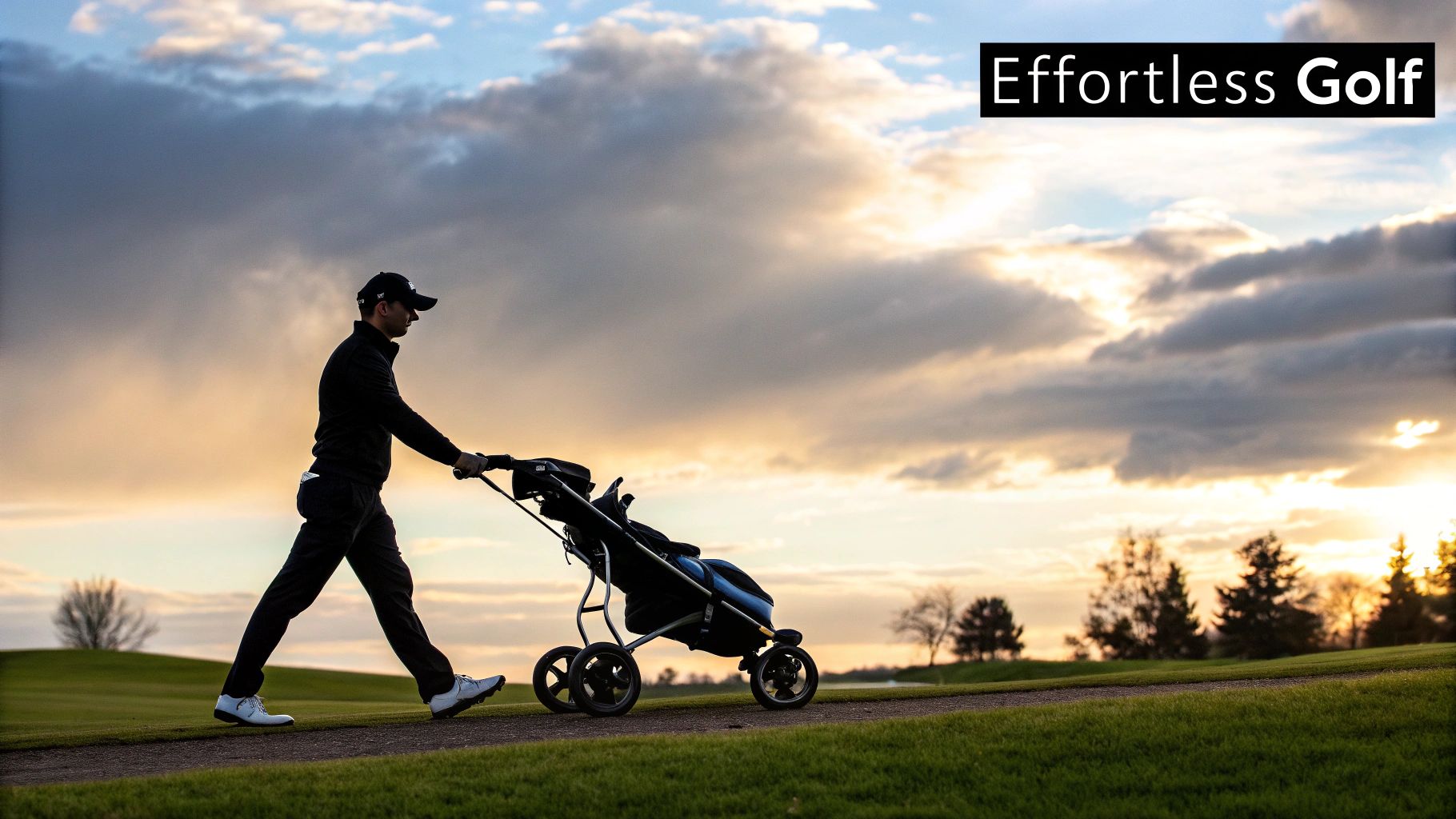
Think about the jump from a regular bicycle to an e-bike. The e-bike doesn't take away the joy or the exercise of the ride; it just smooths out the hills and gets rid of the grind. A power push cart does the exact same thing for a round of golf.
Instead of wrestling a heavy bag up a steep fairway, you're just guiding your motorized caddy with a remote or, with some models, having it follow you automatically. This isn't just a small convenience—it completely changes the physical demands of the game.
For so many of us, the walk is a huge part of the experience. But the fatigue that creeps in from pushing a heavy cart, especially on the back nine, can absolutely tank your performance. When you let a motor handle the load, you show up to every shot feeling fresh and mentally sharp.
Redefining the Walking Golfer Experience
It's no surprise that this corner of the golf world is booming. The global market for golf push carts hit around USD 220 million in 2024 and is on track to more than double by 2033. This isn't just a fad; it’s a real shift away from pricey human caddies toward more practical, personal gear. You can dig into the numbers yourself over at Business Research Insights.
Ultimately, power push cart golf is about making the sport more enjoyable and sustainable for you. It perfectly bridges the gap between carrying your bag and riding in a cart, giving you the best of both worlds:
- Save Your Strength: You get to use your energy for your swings, not for hauling your gear.
- Stay Sharp: Less physical fatigue means better focus and smarter decisions on the course.
- Enjoy the Round More: You can actually appreciate the views and the company without being winded.
By taking away the physical burden, a power push cart lets you get back to the pure strategy and fun of golf. It makes every round, from the first tee to the final putt, that much better.
Why an Electric Caddy Is a Game Changer for Your Round
Making the switch to a power push cart isn't just about convenience—it fundamentally changes how you experience a round of golf. The benefits go way beyond just not having to shove your clubs around. We're talking about a real impact on your physical stamina, your mental game, and how much you actually enjoy being out there.
Imagine walking up to the 18th tee on a hilly course and feeling as fresh as you did on the first. That’s the magic of letting a motor do the heavy lifting. Instead of burning precious energy muscling a 30-pound bag up and down the fairways, you save all that strength for your swing. This is easily the first and most powerful change you'll notice.
Over the long haul, that saved energy really adds up. Golfers using a power push cart golf setup consistently talk about less strain on their back, shoulders, and knees. It simply makes walking the course a more sustainable, comfortable part of the game for years to come.
Sharpen Your Mind and Lower Your Score
When your body isn’t worn out, your mind stays sharp. It’s a simple but powerful equation. Instead of using the walk between shots to catch your breath, you can use that time to actually plan your next move. You’ll have the mental bandwidth to analyze the lie, feel the wind, and pick the right club without the fog of physical exhaustion creeping in.
This boost in focus can have a direct impact on your scorecard. That tricky approach shot over water feels a lot less daunting when your mind is clear and you’re not just trying to recover from a long, uphill trek.
This visual breaks down how a power push cart directly impacts your fatigue, focus, and fun on the course.
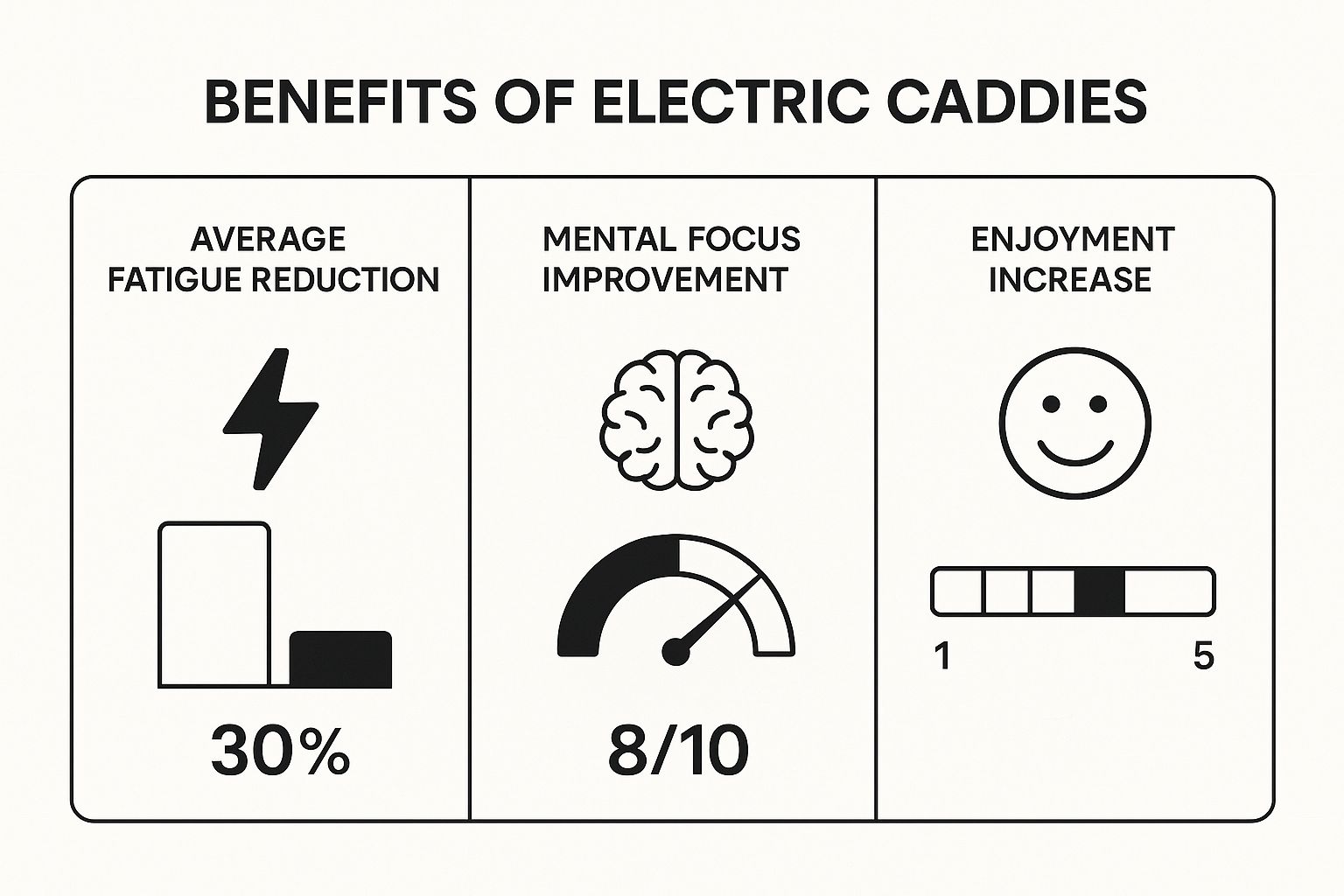
As the infographic shows, the connection is crystal clear: less physical effort leads to sharper mental performance and, ultimately, a more enjoyable game.
Increase Your Enjoyment of the Game
At the end of the day, golf is supposed to be fun. A power push cart helps you get back to the best parts of walking a course—the fresh air, the great views, and the good company—without the physical grind. It takes the "work" out of the walk, leaving you with just the game.
By eliminating the most strenuous part of walking golf, an electric caddy lets you focus 100% on strategy and shot-making, making every round more rewarding.
This isn't just about making one round better; it's about improving your entire relationship with the sport. You can learn more about the specific benefits of electric push carts for golfers in our detailed guide. From preserving your body to sharpening your mind, it truly is a game changer.
Decoding the Must-Have Features of a Power Push Cart
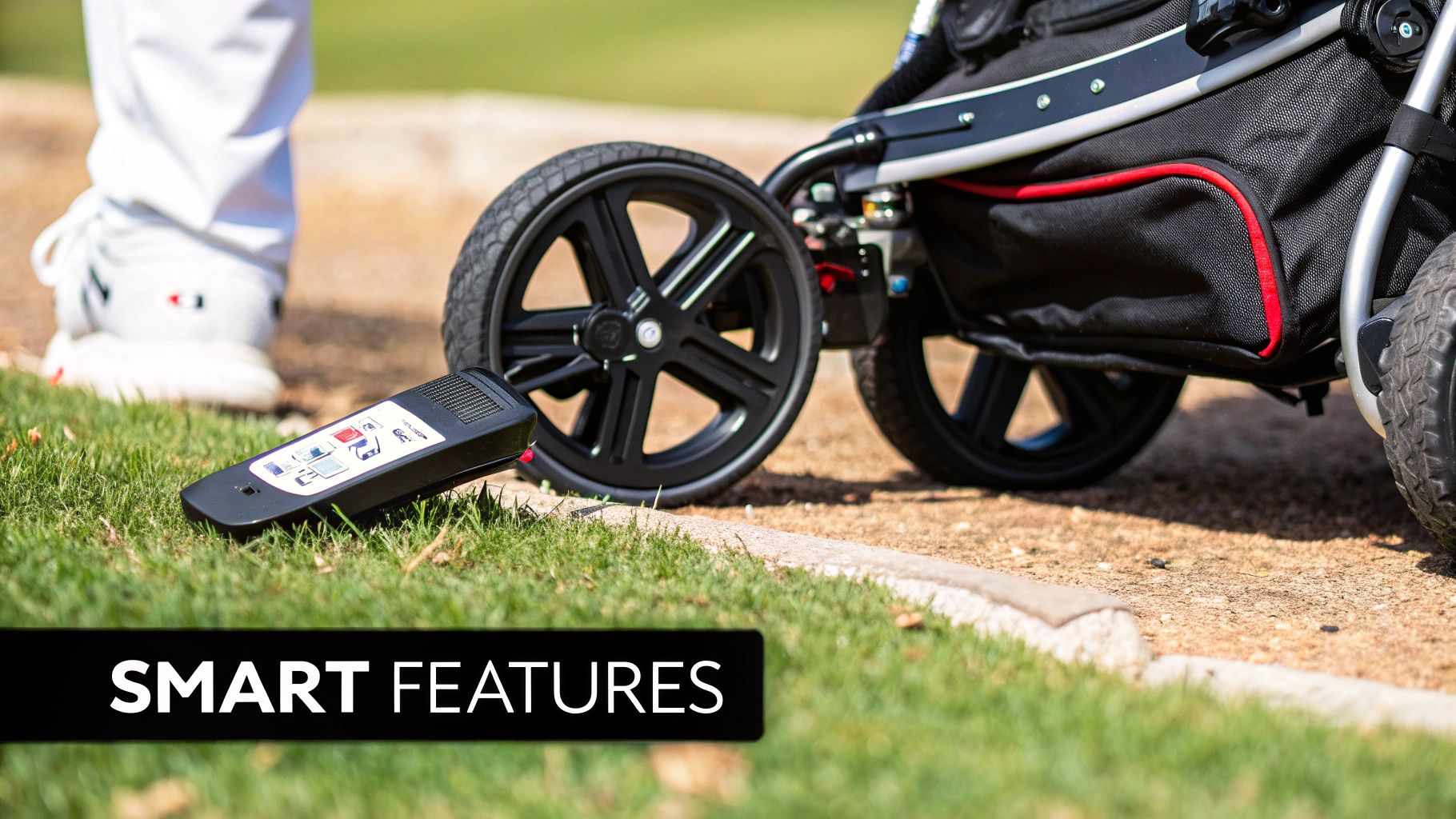
Choosing the right power push cart feels a lot like picking the perfect club—what works for one golfer on a flat links course might not be the best fit for another navigating hilly terrain. To make the right call, you need to look beyond a simple feature checklist and really understand what makes an electric caddy tick.
Let's start with the heart of any power push cart: the battery. You’ll see ratings like "18 holes" or "36 holes," but it's smart to treat those numbers as best-case scenarios. Think of it like a car's MPG sticker—your actual mileage will vary.
A hilly course, a fully loaded bag, and soft, wet turf all force the motor to work harder, which drains the battery faster. A good rule of thumb is to buy a battery rated for more holes than you typically play. This gives you a comfortable buffer, ensuring you’ll always have enough juice to finish your round strong.
Power and Control at Your Fingertips
Today's carts offer sophisticated control systems that go way beyond a simple on/off switch. Your main choices come down to remote control or the more advanced follow mode.
A remote-controlled cart is a fantastic tool for managing your game. You can send your bag ahead to the next tee while you head to the green to putt out, helping maintain a good pace of play. You’re in direct command of the cart's speed and direction from a distance, which is a huge convenience.
Follow mode is the next evolution, offering a true hands-free experience. You just clip a small sensor to your belt, and the cart autonomously trails behind you at a preset distance. It’s the closest you can get to having a digital caddie, letting you focus completely on your walk and your next shot. As you might expect, this premium feature usually comes with a higher price tag.
Stability and Portability
When you look at different models, you'll notice a split between three-wheel and four-wheel designs. The choice here is a classic trade-off: maneuverability versus stability. A three-wheel cart is generally more nimble and easier to turn on a dime. On the other hand, a four-wheel model provides a wider, more stable base that really shines on sidehills and uneven ground.
This demand for stability is a big reason why the global electric golf push cart market, projected to hit $500 million in 2025, is growing so quickly. The four-wheel segment is particularly dominant, thanks to its superior stability and carrying capacity. For a deeper dive into market trends, you can check out insights from Archive Market Research.
To help you sort through what’s most important, here’s a quick comparison of key features to look for.
Power Push Cart Feature Comparison
| Feature | What to Look For | Why It Matters |
|---|---|---|
| Battery Life | Lithium-ion batteries rated for at least 27 holes. | Provides a safety buffer for hilly courses or long rounds, ensuring you never run out of power. |
| Control System | Remote control for convenience, or follow mode for a hands-free experience. | Remote lets you manage pace of play; follow mode lets you focus entirely on your game. |
| Wheel Configuration | 3-wheel for agility, 4-wheel for maximum stability. | Your home course’s terrain will dictate the best choice. Hills and side-slopes favor 4 wheels. |
| Weight & Folding | Lightweight frame (e.g., aluminum) and a one-step folding mechanism. | A cart that's easy to lift and set up makes the transition from your car to the course seamless. |
| Brake System | An easy-to-use foot or hand brake that holds securely. | Essential for safety, especially when parking your cart on an incline while you take a shot. |
Ultimately, the best features are the ones that make your life easier both on and off the course.
A power push cart's weight and folding mechanism are just as important as its on-course performance. A cart that’s a hassle to lift into your car or takes too long to set up can quickly ruin the convenience it’s meant to provide.
Always look for models with an intuitive, one-step folding system and a weight you can comfortably manage. The goal is to find a cart that transitions seamlessly from your trunk to the first tee.
And remember, you don't always have to buy a whole new setup. You can explore options to add a motor to your current cart, too. Our article on the power of a golf push cart motor offers some great insights on that front. By carefully thinking through these features, you can find the perfect power push cart that feels like it was made just for your game.
Choosing Your Course Companion: Manual vs. Power vs. Riding
Deciding how you’ll get your clubs around the course is a bigger choice than you might think. It genuinely shapes your entire experience. Each option—the classic manual push cart, the modern power push cart, and the traditional riding cart—comes with its own unique blend of exercise, convenience, and cost. Getting to know these differences is the key to finding the perfect fit for your game.
The manual push cart has always been the purist's choice. It offers a great workout and keeps you connected to the rhythm of the course. But let's be honest, it also demands the most physical effort. Pushing a heavy bag up a steep hill on a hot day can leave you gassed, and that fatigue can easily creep into your focus and performance on the back nine.
On the other end of the spectrum, a riding cart delivers maximum comfort and speed. It’s the perfect solution for golfers with mobility issues or for those playing on sprawling courses where walking just isn't practical. That convenience, however, comes at a cost—you miss out on the exercise and often find yourself stuck on cart paths, disconnected from the feel of the fairways.
The Balanced Approach of Power Push Cart Golf
This is exactly where power push cart golf finds its sweet spot. It strikes an almost perfect balance, giving you the health benefits of walking without the physical grind of hauling your gear.
You get to enjoy the course on foot, staying limber and loose between shots, but you arrive at your ball feeling fresh and ready to play. It really is the best of both worlds: exercise without the exhaustion.
This trend toward motorized convenience isn't just a niche—it’s reflected across the entire industry. The golf cart market, which includes everything from simple push models to full-sized riding carts, was valued at around USD 1.86 billion in 2024. That number is expected to climb past USD 3.29 billion by 2034, all thanks to innovations that make the game more accessible and fun. You can dig into more of these market trends in this insightful industry report.
Comparing Your Options Side-by-Side
To make the decision a little clearer, let's break down the core factors for each method. Think about what you value most during a round. Is it the workout? The social time? Speed? Or just keeping costs down?
| Factor | Manual Push Cart | Power Push Cart | Riding Cart |
|---|---|---|---|
| Physical Exertion | High | Low | Minimal |
| Initial Cost | Low ($150 - $400) | Moderate ($500 - $2,500+) | N/A (Rental) |
| Ongoing Cost | None | Minimal (Charging) | High (Rental Fees) |
| Pace of Play | Moderate | Fast (Walker) | Fastest |
| Course Experience | Engaged Walking | Engaged Walking | Detached Riding |
As the table shows, a manual cart is the most budget-friendly upfront, but those riding cart rental fees can really add up over a season.
The power push cart emerges as the ideal middle ground. It delivers a walking experience that’s both physically manageable and immersive, preserving your energy for your swing while keeping you connected to the rhythm of the game.
Ultimately, the right choice boils down to your personal priorities. If you want the exercise and have the stamina, a manual cart is a fantastic, affordable option. If speed and comfort are all that matter, a riding cart is the clear winner.
But for the golfer who wants to walk the course, save their energy, and sharpen their focus, the power push cart is an undeniable champion.
How the Caddie Wheel Unlocks an Affordable Upgrade Path
Look, not everyone is ready to drop a ton of cash on a brand-new power push cart. That's totally understandable, especially if you already have a manual push cart you know and love. This is where a smarter, more accessible path to power push cart golf opens up—one that doesn’t force you to start from scratch. Why replace your trusty gear when you can just upgrade it?
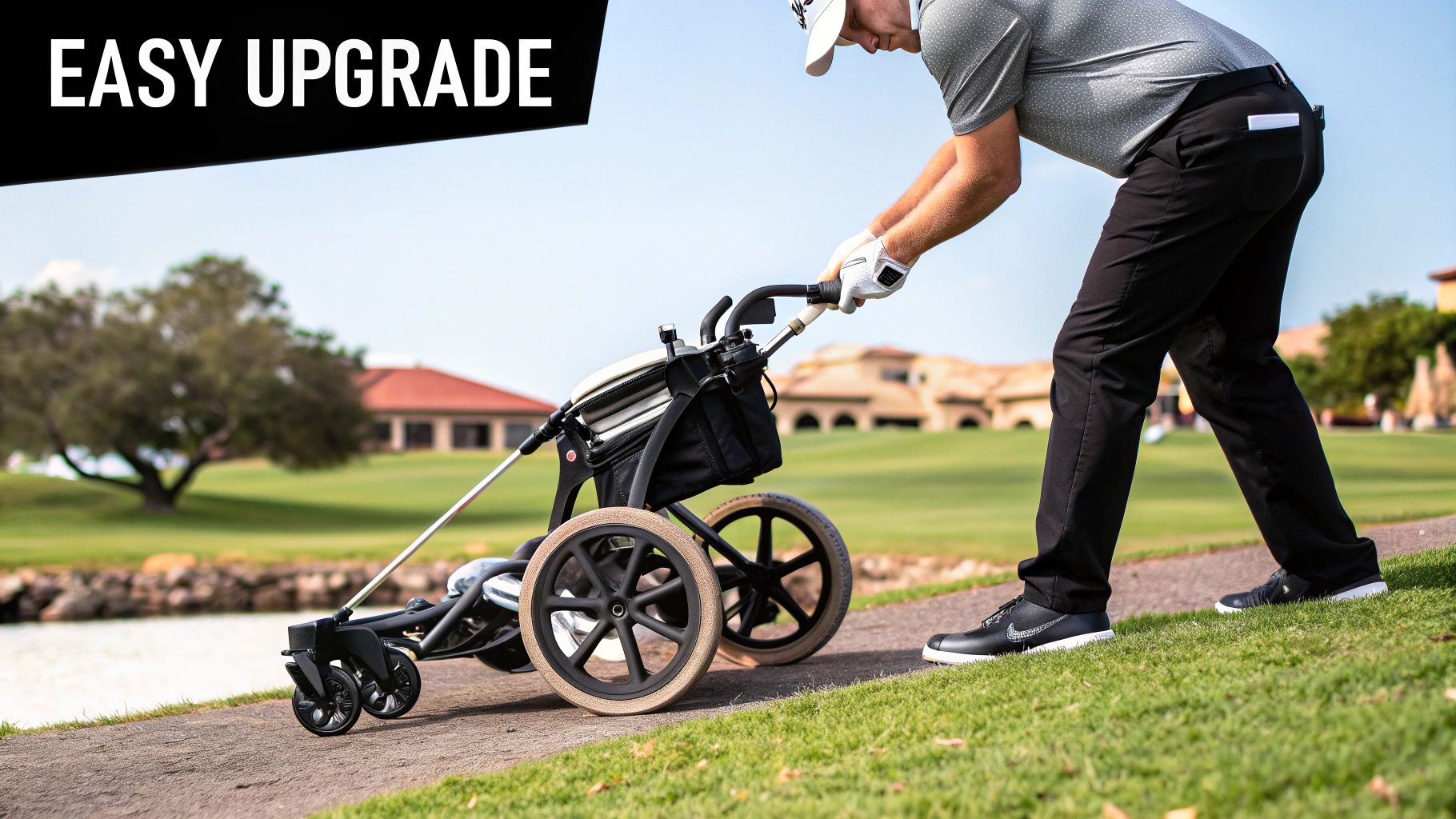
The Caddie Wheel is an electric conversion kit built to do exactly that. Think of it like dropping a powerful engine into your reliable family car instead of buying a whole new vehicle. You get the full experience of motorized assistance without the steep price tag and the waste of ditching perfectly good equipment.
The Smart Money Move: Cost and Sustainability
The most obvious win here is the cost savings. A new, high-end electric caddy can easily set you back over $1,300, which is a major investment for most of us. A conversion kit like the Caddie Wheel delivers the same core functionality—motorized power, remote control, and effortless hill climbing—for a fraction of that price.
This approach is also the more sustainable choice. By retrofitting your existing push cart, you’re extending its life and keeping it out of a landfill. It's a practical way to give your reliable cart a new lease on life while modernizing your game responsibly.
A conversion kit bridges the gap between manual effort and a fully electric system, offering a budget-friendly and eco-conscious way to upgrade your game.
Installation Made Simple
The idea of modifying your gear might sound intimidating, but the process is surprisingly simple. We engineered the Caddie Wheel for a no-fuss installation that most golfers can knock out in just a few minutes. You won't need a toolbox full of specialized equipment, either.
Here’s the gist of how it works:
- Attach the Bracket: A universal mounting bracket secures right onto the rear axle of your existing push cart.
- Mount the Motorized Wheel: The Caddie Wheel unit simply slides onto this bracket and clicks securely into place.
- Position the Remote: Clip the remote holder onto your cart’s handle, and you’re good to go.
This drop-on design means you can quickly transform your manual cart into a remote-controlled powerhouse right before a round. When you're done, it comes off just as easily for transport or storage. It’s an efficient system that puts the focus back on convenience.
For a detailed walkthrough, you can check out this complete guide to a golf push cart electric conversion kit to see just how easy it is.
Got Questions About Power Push Carts? We've Got Answers.
Making the switch to a power push cart is a big decision, and it’s smart to have a few final questions before you pull the trigger. Think of this section as a chat with your local course pro—I'm here to give you the straight scoop on how these carts really perform out on the course.
We’ll dig into the nitty-gritty of battery life on hilly tracks, what daily upkeep actually looks like, and whether you can trust your cart when the weather turns. By the end, you'll have the full picture and be ready to make a confident choice.
How Does a Hilly Course Affect Battery Life?
This is probably the most important question we get, and for good reason. The answer directly impacts your peace of mind on the course. While manufacturers often advertise battery life by the number of holes—say, 18 or 36—those numbers are almost always based on a perfectly flat, ideal course. We all know most courses aren't like that.
The truth is, hilly terrain is the biggest battery drainer. The motor has to work much harder to climb those inclines, pulling way more juice from the battery. A battery that's rated for 27 holes on a flat layout might only give you 18 to 22 holes on a challenging, rolling course. Other things like a heavy tour bag, soft and soggy turf, and even cold weather will also chip away at the battery's total output.
Here's a solid rule of thumb: always buy a battery rated for more holes than you typically play. It creates a comfortable buffer, so you're never sweating it on the 16th fairway, wondering if you'll make it back to the clubhouse.
Is It Difficult to Maintain a Power Push Cart?
Thankfully, not at all. Modern power push carts are built to be low-maintenance. The most important job you have is taking care of the battery. That just means using the charger that came with it, trying not to run the battery completely dead, and storing it somewhere temperature-controlled, like your garage—not the trunk of a hot car.
Beyond that, the upkeep is pretty much identical to a regular push cart.
- Keep it clean: Give the frame a wipe-down and make sure the wheels are clear of grass and mud.
- Check the connections: Every once in a while, just make sure the bolts and fasteners feel snug.
- Store it dry: After a round, especially a wet one, let it dry off properly before storing it.
For a conversion kit like the Caddie Wheel, it's even simpler. You’re really just managing the motorized wheel and its battery. Your cart frame remains the same easy-to-care-for piece of gear you've always had.
Can I Use My Power Push Cart in the Rain?
Most modern power push carts are water-resistant, but they aren't fully waterproof. What this means is they’re designed to handle a light drizzle, morning dew, and generally damp conditions just fine. The key electronic parts—the motor, battery case, and controls—are sealed up to keep moisture out.
However, they aren't meant to be used in a torrential downpour or driven through deep puddles. If you get caught in some serious rain, it's best to head for cover. After any wet round, it's a great habit to wipe the cart down with a dry towel, paying special attention to the electronic components. That little step goes a long way in preventing any long-term moisture issues.
What Is the Difference Between Remote Control and Follow Mode?
These are two different features that offer two different kinds of on-course luxury. A remote-controlled cart is all about direct command. You use a small handheld remote to steer the cart, change its speed, or even send it ahead to the next tee while you walk over to the green. It’s fantastic for keeping a good pace of play.
Follow mode, on the other hand, is a more hands-free, autonomous experience. You clip a small sensor to your belt or back pocket, and the cart just... follows you. It maintains a set distance behind you as you walk down the fairway, creating a true "digital caddie" feel that lets you focus completely on your next shot. Carts with follow technology are usually the more premium option compared to the remote-only models.
Ready to transform your walk and elevate your game? The Caddie Wheel makes it easy and affordable to upgrade your existing push cart with powerful, remote-controlled convenience.
Discover the Caddie Wheel and enjoy a better round of golf today!

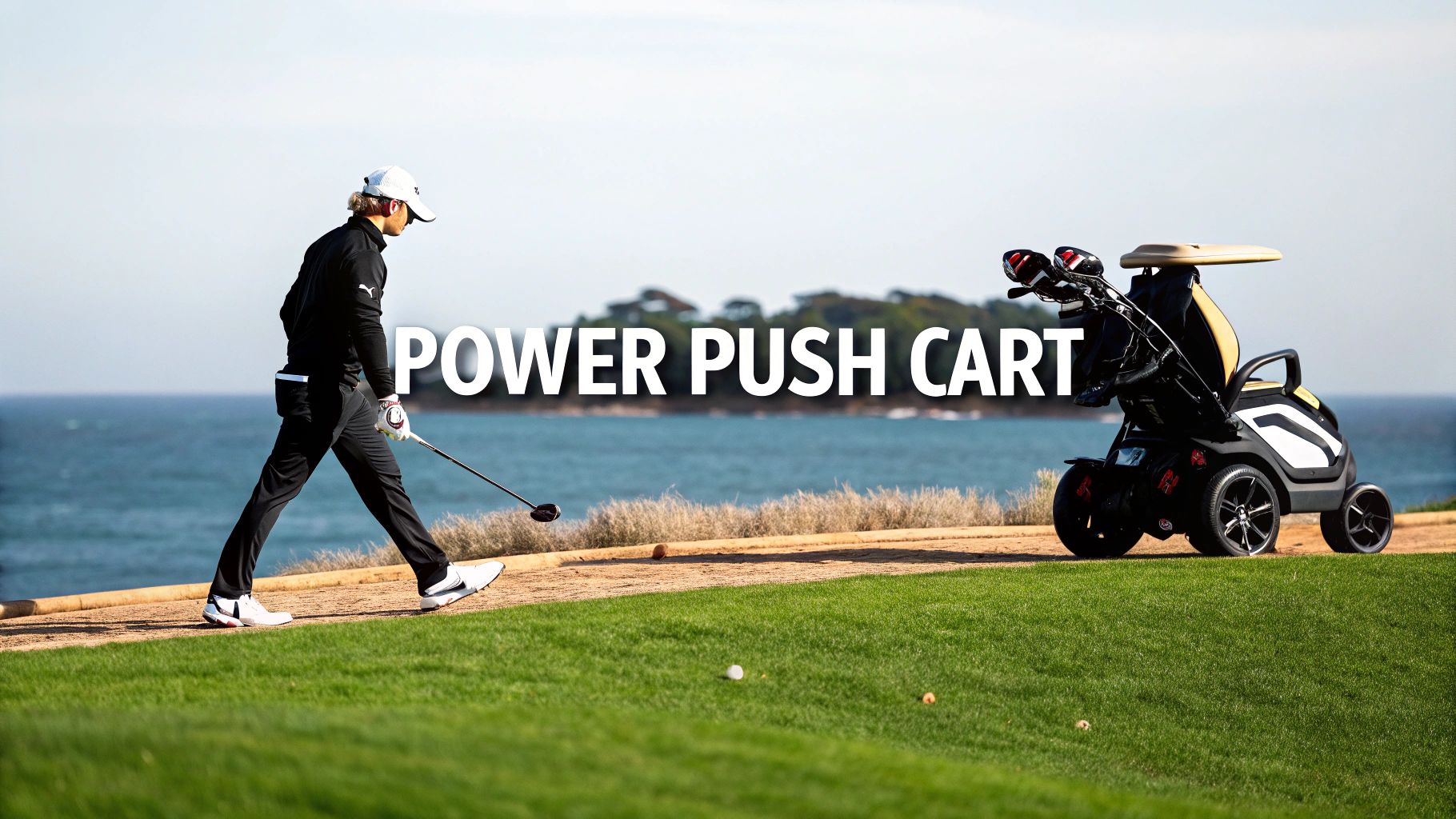
Share:
Choosing Your Golf Cart Bag Cooler Guide
A Guide to Remote Control Electric Golf Carts